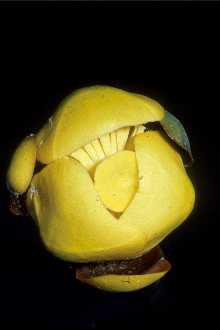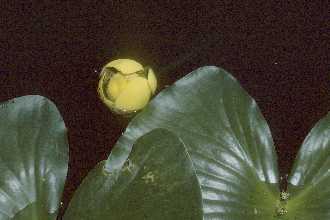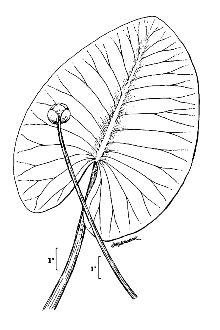Yellow Pond-lily
Scientific Name: Nuphar lutea (L.) Sm.

| General Information | |
|---|---|
| Usda Symbol | NULU |
| Group | Dicot |
| Life Cycle | Perennial |
| Growth Habits | Forb/herb |
| Native Locations | NULU |
Plant Guide
Alternate Names
Brandy-bottle, bullhead lily, Nuphar variegatum, spatterdock, yellow cowlily. Nuphar lutea is divided into many subspecies. Comparisons of morphological features and interpretations of molecular analysis indicate the name Nuphar lutea should not be used for any North American Nuphar members. The genus Nuphar is now represented by eight distinct species in North America. A key to this new classification is provided in Flora of North America, volume 3, by Kartesz (1997) and Aquatic and Wetland Plants of Northeastern North America, volume 1, by Crow and Hellquist (2000).
Uses
Ethnobotanic: Native Americans consumed the starchy rootstocks as boiled or roasted vegetables and harvested the seed for grinding into flour, There are some accounts of the root being powdered and used as a poultice, Wildlife: Yellow pond-lily provides food and shelter for many fish and underwater insects, Ornamental: Yellow pond-lily flowers and leaves are showy and fragrant, Use soil moisture sensors to measure the soil moisture of Yellow Pond-lily., For this reason, it is used as an ornamental planting in water gardens and ponds,
Legal Status
Status
Status
Yellow pond-lily is a noxious aquatic weed in Puerto Rico. Please consult the PLANTS Web site (http://plants.usda.gov) and your State Department of Natural Resources for this plant’s current status (e.g. threatened or endangered species, state noxious status, and wetland indicator values). D. Bayne @ AquaPlant Database. 2000. Texas Cooperative Extension.
Weediness
This plant may become weedy in some regions or habitats and may displace desirable vegetation if not properly managed. Please consult with your local NRCS Field Office, Cooperative Extension Service office, or state natural resource or agriculture department regarding its status and use. Weed information is also available from the PLANTS Web site at plants.usda.gov.
Description
General: Water Lily Family (Nymphaeaceae). Yellow pond-lily is an aquatic perennial that grows to be 15 to 60 cm in height and spreads 1 to 2 m on the water surface. Spongy rhizomes anchor into the muddy bottom of a water body and give rise to long, stout stems. Submerged leaves are thin and attached to the rhizomes. Floating leaves are thick, somewhat heart-shaped, wavy along the margins, have up to a 40 cm spread, and are attached to the stems. Flowers emerge on separate stem stalks. They are cup-shaped, yellow-green, with small scale-like petals and numberous stamens and stigmas hidden within the thick showy sepals. Flowers bloom from May to October, partially opening in the morning and closing at night. Spent flowers give way to seed heads that burst upon ripening, broadcasting their seeds over the water surface. Flowers and leaf stems die back to the rhizome in autumn. Yellow pond-lily may be confused with water lily, Nymphaea species, which have rounder leaves and showier pink to white flowers. Distribution: Yellow pond-lily is native to the Eastern United States, Africa, Temperate Asia, the West Indies, and Europe. It is naturalized in most temperate regions of North America. It occurs in all 50 states except Hawaii. For current distribution, please consult the Plant Profile page for this species on the PLANTS Web site (http://plants.usda.gov). Habitat: Yellow pond-lily occurs in slow-moving streams, still ponds, and lakes.
Adaptation
The USDA hardiness zones for yellow pond-lily are 4 to 10. It grows in wet, poor sandy soils and performs best in 1 to 3 feet of water in full sun to part shade. It is more tolerant of shade and deep water than Nymphaea species. It is more often used in large water gardens and ponds where it can produce underwater stems that grow up to 2 m long and can slowly spread to form sizeable colonies.
Establishment
Yellow pond-lily should be grown in containers if they are used for water gardens. For natural ponds, plant rhizomes directly in the muddy bottom if naturalization is desired.
Seeds and Plant Production
Plant Production
Plant Production
Seeds are produced and deposited on the water surface, where they are carried to a germination spot. Yellow pond-lily reproduces more readily by spreading rhizomes.
Control
Although this plant is not considered invasive, it is very difficult to eradicate when not grown in containers because any section of rhizome left behind may sprout new growth. Please contact your local agricultural extension specialist or county weed specialist to learn what works best in your area and how to use it safely. Always read label and safety instructions for each control method. Trade names and control measures appear in this document only to provide specific information. The USDA NRCS does not guarantee or warranty the products and control methods named, and other products may be equally effective. Cultivars, Improved and Selected Materials (and area of origin) Contact your local Natural Resources
Conservation
Service (formerly Soil Conservation Service) office for more information. Look in the phone book under ”United States Government.” The Natural Resources Conservation Service will be listed under the subheading “Department of Agriculture.”


